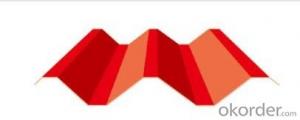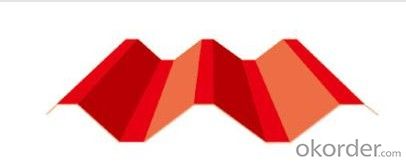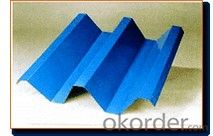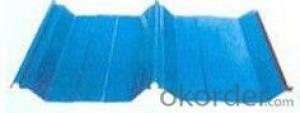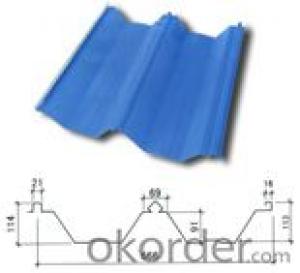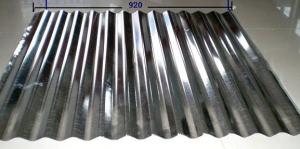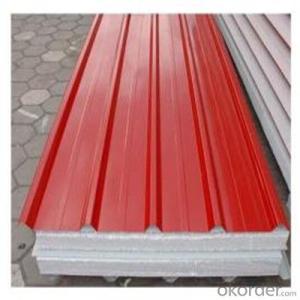EXCELLENT CORRUGATED STEEL SHEET RED-BLUE
- Loading Port:
- China Main Port
- Payment Terms:
- TT OR LC
- Min Order Qty:
- -
- Supply Capability:
- -
OKorder Service Pledge
OKorder Financial Service
You Might Also Like
EXCELLENT CORRUGATED STEEL SHEET RED-BLUE
Corrugated sheets are made from Galvanized steel coils, Galvalume Steel coils, Galvalume Pre-
painted sheet and aluminum sheet, prepainted hot dip galvanized steel coils, roll formed by roll forming machines, the thickness and color can be different.
Our products have significant advantages as below:
1)lower price and best quality
2)waterproof and fire insulation
3)light weight
4)fast and convenient istallation
5)different color
6)high strength
7)Durable
8)free of maintenance
9)beautiful appearance
The followings are the trade terms:
1)Package: 1 to 2 tons/package by kraft paper and wood pallet(packing size can be made as per your requirement as well)
2)Minimum Order Quantity: 1000 square meters
3)Delivery Time: 15 days upon down payment or LC
4)Payment terms: by TT or LC
Product Details:
Place of Origin | China (Mainland) |
Brand Name | CNBM |
Model Number | 900 |
Material | Color Steel |
Color | any color is available |
Payment & Shipping Terms:
Price: | FOB USD 2~5 / Meter |
Minimum Order Quantity: | Negotiable Trial Order |
Minimum Order Quantity: | 20 Ton/Tons 20 MTTrial Order |
Port: | XINGANG |
Packaging Details: | waterproof paper, steel strip, iron sheet, C chaneel |
Delivery Time: | 25 days after receiving deposit |
Payment Terms: | L/C,T/T |
Supply Ability: | 250000 Ton/Tons per Year 20 MT |
Roofing color corrugated steel sheet
1) Max. width: 600- 980mm
2) Thickness: 0.236-1.00mm(commonly 0.3-0.6mm)
3) Length:Less than 12m
Roofing color corrugated steel sheet
1. Base sheet: galvanized steel sheet
2. Standard: JIS, ASTM, GB
3. Thickness: 0.14mm—0.5mm
4. Width: 762mm, 914mm, 1000mm before corrugation
Raw material 762mm to 665 mm, 660mm(after corrugated) an d 9 waves
Raw material 914mm to 800mm, 810mm(after corrugated) and 11 waves
Raw material 1000mm to 875mm, 880mm, 890mm,900mm, 914mm(after corrugated) and 12 waves
5. Zinc: 60g--180g/m2
6. Color: All colors according to RAL color system
7. Package: covered by one layer of pvc film on the surface of steel sheet, or in bundle.
8. Features: light-weight, high-strength, erosion-resistant, quakeproof, easy-installation, colorful, anti-rust, long life, etc.
9. Application: steel structure workshop, sandwich panel workshop, transportation, outside decoration of various buildings, home appliances like refrigerator, air conditioner, electric cookware, etc
- Q: How are steel coils used in the production of construction machinery?
- Steel coils are used in the production of construction machinery as they are a primary raw material for manufacturing various components such as structural frames, chassis, and other heavy-duty parts. These coils are typically processed and fabricated through cutting, bending, welding, and shaping techniques to create the required components that form the foundation of construction machinery.
- Q: I need to identify a metal. It is rusty so I suspect it is either iron or steel. Since they both have similar densities and are magnetic, how do I tell the difference betweeen steel and iron?
- Iron and Steel Manufacture, technology related to the production of iron and its alloys, particularly those containing a small percentage of carbon. The differences between the various types of iron and steel are sometimes confusing because of the nomenclature used. Steel in general is an alloy of iron and carbon, often with an admixture of other elements. Some alloys that are commercially called irons contain more carbon than commercial steels. Open-hearth iron and wrought iron contain only a few hundredths of 1 percent of carbon. Steels of various types contain from 0.04 percent to 2.25 percent of carbon. Cast iron, malleable cast iron, and pig iron contain amounts of carbon varying from 2 to 4 percent. A special form of malleable iron, containing virtually no carbon, is known as white-heart malleable iron. A special group of iron alloys, known as ferroalloys, is used in the manufacture of iron and steel alloys; they contain from 20 to 80 percent of an alloying element, such as manganese, silicon, or chromium.
- Q: What are the different types of packaging for steel coils?
- The different types of packaging for steel coils typically include wooden crates, steel frames, and plastic wrapping. These packaging materials are used to provide protection and secure the steel coils during transportation and storage.
- Q: What are the advantages of using steel coils over other materials?
- There are several advantages of using steel coils over other materials. Firstly, steel is highly durable and has a long lifespan, making it ideal for various applications. Secondly, steel coils have excellent strength and can withstand heavy loads and extreme weather conditions. Thirdly, steel is recyclable and environmentally friendly, ensuring sustainability. Additionally, steel coils provide superior corrosion resistance, reducing maintenance costs. Lastly, steel offers versatility in terms of customization, allowing for various shapes, sizes, and thicknesses to meet specific requirements.
- Q: Can steel coils be coated with scratch-resistant materials?
- Yes, steel coils can be coated with scratch-resistant materials. These materials can provide a protective layer that minimizes the risk of scratches and damage to the steel coils during transportation, handling, and storage.
- Q: Can steel coils be coated with epoxy?
- Yes, steel coils can be coated with epoxy. Epoxy coatings provide protection against corrosion and enhance the durability and lifespan of the steel coils.
- Q: How are steel coils inspected for camber using laser profiling?
- The inspection of steel coils for camber involves the use of laser profiling, a measurement technique that does not require physical contact. Laser profiling works by emitting a laser beam onto the surface of the steel coil, creating a detailed profile of its surface. To detect camber, the laser profiling system scans the entire length and width of the coil, capturing data points at regular intervals. These data points are then analyzed to determine the deviation from a straight line, indicating the presence of camber. During the inspection process, the measured profile of the steel coil is compared to a reference profile, which represents an ideal or straight surface. The deviation between the measured profile and the reference profile is calculated, and if it exceeds a predetermined threshold, the coil is flagged as having camber. The use of laser profiling offers several advantages for camber inspection of steel coils. Firstly, it eliminates the need for physical contact, reducing the risk of damage. Additionally, laser profiling is highly accurate, capable of detecting even small deviations in the coil's surface. This ensures reliable detection of camber, allowing for necessary corrective actions to be taken. Overall, laser profiling is an efficient and accurate method for inspecting steel coils for camber. It enables manufacturers to maintain high-quality standards and deliver reliable products to customers.
- Q: What are the different methods of edge trimming steel coils?
- Manufacturers have various methods at their disposal for edge trimming steel coils, which are chosen based on their specific preferences and requirements. Some commonly used methods include: 1. Slitting: This method involves passing the coil through rotating circular blades to precisely cut the edges. It is suitable for different thicknesses of steel coils. 2. Milling: By using milling cutters, excess material is removed to achieve the desired edge finish. Milling is often employed for thicker steel coils or when a specific edge profile is needed. 3. Shearing: A sharp blade is used to cut the steel coil along a straight line, providing a clean and straight edge. This method is commonly used for thinner steel coils. 4. Laser cutting: Edge trimming is achieved by utilizing a focused laser beam to melt or vaporize the excess material, resulting in a precise and smooth edge. Laser cutting is often preferred for thinner gauges or when intricate shapes or patterns are necessary. 5. Water jet cutting: This method involves a high-pressure stream of water mixed with abrasive particles to trim the edges of the steel coil. Water jet cutting offers a versatile and precise cutting solution, particularly for thicker steel coils and complex shapes. Manufacturers should carefully assess their specific requirements, including coil thickness, desired edge finish, speed, and cost, to choose the most suitable edge trimming method for their steel coils.
- Q: what do they use to make stainless steel?and can stainless steel be melted again and again without losing it's Specifications
- This Site Might Help You. RE: What are the components of Stainless Steel? what do they use to make stainless steel? and can stainless steel be melted again and again without losing it's Specifications
- Q: How are steel coils used in the production of pipes and tubes?
- Steel coils are used in the production of pipes and tubes by being fed into a pipe or tube mill, where they are unraveled, formed, and welded together to create the desired size and shape of the pipe or tube.
Send your message to us
EXCELLENT CORRUGATED STEEL SHEET RED-BLUE
- Loading Port:
- China Main Port
- Payment Terms:
- TT OR LC
- Min Order Qty:
- -
- Supply Capability:
- -
OKorder Service Pledge
OKorder Financial Service
Similar products
Hot products
Hot Searches
Related keywords
